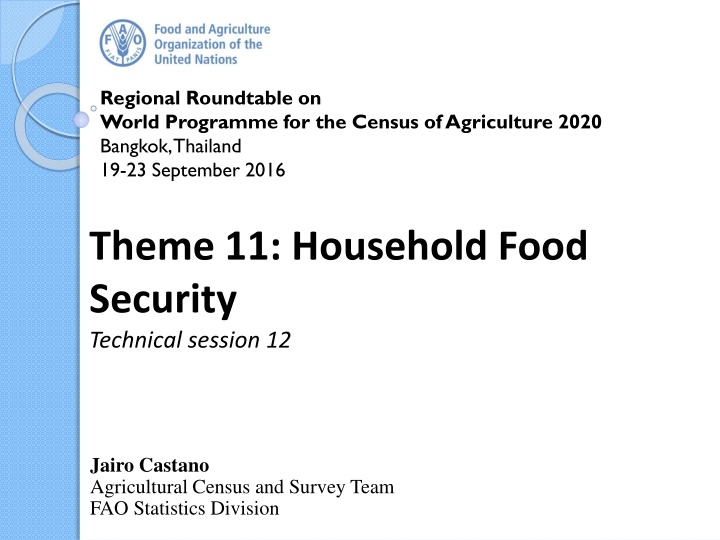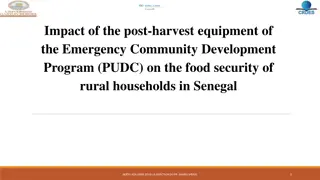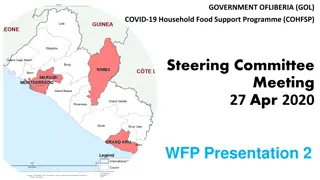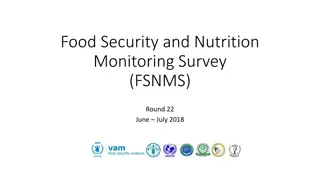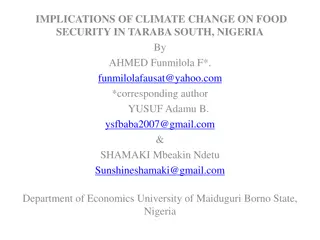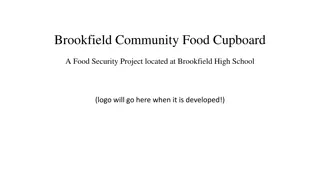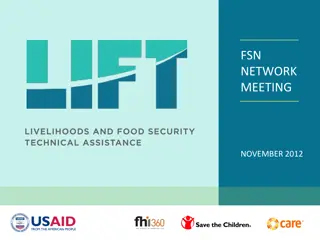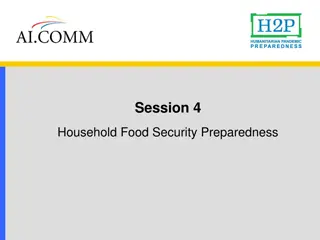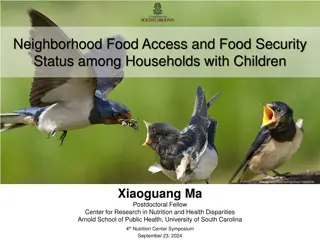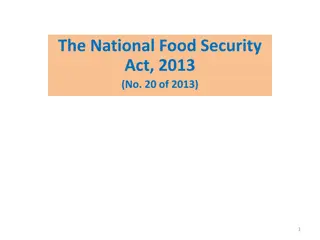Innovations in Measuring Household Food Security: FIES Approach
Household food security is a fundamental aspect of well-being, yet challenging to measure accurately. The Food Insecurity Experience Scale (FIES) offers a new approach developed by the FAO, aiming to assess food insecurity experiences through specific questions. This innovative method provides valuable insights into individuals' actual food security status, contributing to global efforts to combat hunger and ensure sustainable development.
Download Presentation

Please find below an Image/Link to download the presentation.
The content on the website is provided AS IS for your information and personal use only. It may not be sold, licensed, or shared on other websites without obtaining consent from the author.If you encounter any issues during the download, it is possible that the publisher has removed the file from their server.
You are allowed to download the files provided on this website for personal or commercial use, subject to the condition that they are used lawfully. All files are the property of their respective owners.
The content on the website is provided AS IS for your information and personal use only. It may not be sold, licensed, or shared on other websites without obtaining consent from the author.
E N D
Presentation Transcript
Regional Roundtable on World Programme for the Census of Agriculture 2020 Bangkok, Thailand 19-23 September 2016 Theme 11: Household Food Security Technical session 12 Jairo Castano Agricultural Census and Survey Team FAO Statistics Division
Contents Background Household food security: Basic concepts The FIES (Food Insecurity Experience Scale) approach Items Concepts and definitions Country experiences 2
Background After the WCA 2010 Programme, in 2013 the FAO project Voices of the Hungry (VoH), developed a new approach in order to measure household food security in a reliable and relatively inexpensive way through experience-based food insecurity scales. Through this approach, the food insecurity experience is measured by means of eight subitems or questions aimed at revealing what has been actually experienced by a given individual or by the members of a given household. On the basis of the eight standard, the Food Insecurity Experience Scale (FIES). questions, FAO has developed a new Theme 11 of the WCA 2020 recommends the innovative FIES approach to the measurement of food insecurity. 3
Household food security: Basic concepts Household food security refers to the situation in which all members of a household at all times are consuming enough safe and nutritious food for normal growth and development and for an active and healthy life. A household is food-insecure if it is not able to procure enough food or if its members are unable to eat adequate safe or nutritious food due to limited resources. The inclusion of food security in the census is challenging because of it is difficult to estimate with sufficient precision households habitual food consumption patterns. To cope with a complex, multidimensional issue, in Voices of the Hungry (VoH) developed an innovative approach to access timely and valid information on the severity of food insecurity as experienced by individuals: the Food Insecurity Experience Scale (FIES). 2013, FAO project UNSC adopted FIES as SDG indicator 2.1.2 Prevalence of population with moderate or severe food insecurity of Target 2.1 End hunger . 4
Items Theme 11 is organized in three items. The first one is open in the eight questions of the FIES. Therefore 10 subitems need to be described. 1101 The food insecurity experience scale (FIES); 1102 Effects of natural disasters (for the household); 1103 Extent of loss of agricultural output due to natural disasters (for the household) 5
Item 1101: Food insecurity experience scale (FIES) Type: Additional item. New item. Reference period: Census reference year. The eight questions of the FIES (Questions (a), (b), (c), (d), (e), (g) & (h) are referred to household members whilst question (f) refers to the household as a whole (expressions in brackets allow to extend the individual assessment to the whole household): During the last 12 months, was there a time when you [or any other adult in your household]: 1101(a) were worried you would not have enough food to eat because of a lack of money or other resources? 1101(b) were unable to eat healthy and nutritious food because of a lack of money or other resources? 1101(c) ate only a few kinds of foods because of a lack of money or other resources? 1101(d) had to skip a meal because there was not enough money or other resources to get food? 1101(e) ate less than you [he/she] thought you [he/she] should because of a lack of money or other resources? 1101(f) During the last 12 months, was there a time when your household ran out of food because of a lack of money or other resources? 1101(g) were hungry but did not eat because there was not enough money or other resources for food? 1101(h) went without eating for a whole day because of a lack of money or other resources?6
Sub-item 11019(a) (a): During the last 12 months, was there a time when you [or any other adult in your household] were worried you would not have enough food to eat because of a lack of money or other resources? Concept: This question refers to a state of being worried, anxious, apprehensive, afraid or concerned that there might not be enough food or that the respondent will run out of food because there is not enough money or other resources to get food. 7
Sub-item 1101(b) (b): During the last 12 months, was there a time when you [or any other adult in your household] were unable to eat healthy and nutritious food because of a lack of money or other resources? Concept: This question asks the respondent whether s/he was not able to get foods they considered healthy or good for them, foods that make them healthy, or those that make a nutritious or balanced diet because there was not enough money or other resources to get food. Notes: The answer depends on the respondent s own opinion of what they consider to be healthy and nutritious foods. This question refers to the quality of the diet and not the quantity of foods eaten. 8
Subitem 1101(c) (c): During the last 12 months, was there a time when you [or any other adult in your household] ate only a few kinds of food because of a lack of money or other resources? Concept: The question asks if the respondent was forced to eat a limited variety of foods, the same foods, or just a few kinds of foods every day because there was not enough money or other resources to get food. Note: This question refers to the quality of the diet and not the quantity of foods eaten. 9
Subitem 1101(d) (d): During the last 12 months, was there a time when you [or any other adult in your household] had to skip a meal because there was not enough money or other resources to get food? Concept: This question inquires about the experience of having to miss or skip a major meal (for example, breakfast, lunch or dinner) that would normally have been eaten because there was not enough money or other resources to get food. Note: This question refers insufficient quantity of food. 10
Subitem 1101(e) (e): During the last 12 months, was there a time when you [or any other adult in your household] ate less than you thought you should because of a lack of money or other resources? Concept:This question inquires about eating less than what the respondent considered they should, even if they did not skip a meal, because the household did not have money or other resources to get food. Notes: The answer depends on the respondent s own opinion of how much they think they should be eating. This question refers insufficient quantity of food. It should never be intended as referring to special diets to lose weight or for health or religious reasons. 11
Subitem 1101(f) (f): During the last 12 months, was there a time when your household ran out of food because of a lack of money or other resources? Concept:This question refers to any occasion when there was actually no food in the household because members did not have money, resources, or any other means to get food. other 12
Subitem 1101(g) (g): During the last 12 months, was there a time when you [or any other adult in your household] were hungry but did not eat because there was not enough money or other resources for food? Concept:This question asks about the physical experience of feeling hungry, and specifically, feeling hungry and not being able to eat enough because of a lack of money or resources to get enough food. Note: The question does not refer to possible consequences of special diets to lose weight or of fasting for health or religious reasons. 13
Sub-item 1101(h) (h): During the last 12 months, was there a time when you [or any other adult in your household] went without eating for a whole day because of lack of money or other resources ? Concept:This question asks about a specific behaviour not eating anything all day because of a lack of money and other resources to get food. Note: The question does not refer to special diets to lose weight or to fasting for health or religious reasons. 14
Item 1102: Effects of natural disasters (for the household) Type:Additional item. Reference period: Census reference year. Concept: This item refers to whether the household s food security situation was affected by specified natural disasters. It is suitable for countries where natural disasters are prevalent and they can have a major impact on the food security situation of people affected. Note: For the purposes of the agricultural census, natural disasters include the major climatic and physical events, as well as major pest attacks. Typical types of natural disasters: Floods or tidal waves Drought Typhoons or hurricanes Pests Other 15
Item 1103: Extent of loss of agricultural output due to natural disasters (for the household) Type: Additional item. Reference period: Census reference year. Concept: This item covers the extent of the loss as a result of the disasters reported in Item 1102. Examples of criteria to measure the extent of loss: None Slight Moderate Severe Note: Normally, this item relates to the overall effect of the natural disasters, not the effects of specific disasters or the effects on specific crops or livestock. For crops, loss is usually assessed in terms of the effect on crop production in comparison with a normal year, such as: slight: less than 20% lower; moderate : 20-40% lower; severe : more than 40% lower. Similar criteria can be used for livestock. 16
Country experiences (refer to WCA 2010) Nicaragua. National Agricultural Census 2011 Section XVI of the census questionnaire is devoted to food security. The following questions were included: Q. 83: From the produce or the sale of the produce of this holding, has your household experienced any of the following situations?: 1) Did not get enough money to buy food; 2) Suffered from food shortage; 3) It was enough for home consumption; 4) None of the previous situations (in case of answers 3) or 4) Q. 84 and 85 had to be skipped. Q. 84: In which months did your household experience such situation? Q. 85: How did your household cope such situation?: 1) Looking for a new job; 2) With government help; 3) With NGO s help; 4) With remittances; 5) With help from relatives, neighbors or friends; 6) Selling assets; 7) Migrating; 8) Other form (specify); 9) Not coped. Q. 86: During the last agricultural year has your household gone through any of the following situations?: 1) Skip some meals; 2) Eat cheaper foods; 3) Eat less foods; 4) Other (specify); 5) None (go to Q. 88). Q. 87: In which months did your household experience such situation? Q. 88: Do you think that in the next agricultural year your household will have a similar situation? 17
Country experiences (referred to WCA 2010) Bhutan. Renewable natural resources census 2009 Section 8 of the census questionnaire is devoted to Food Security asking 3 questions: Q. 8.1: Did you produce enough food-grain for your household s consumption in 2008? Options: a) enough; b) Not enough; c) Food-grain production not feasible here. If No enough: Which months did you face food-grain shortages? Q. 8.2: How do you cope with the shortages? 1) Purchase from market; 2) Sale of: a) potatoes; b) vegetables; c) fruits; d) other cash crops (specify); 3) Borrowed from neighbors; 4) Sale of: a) livestock dairy and meat products; b) forest and by- products; 5) Barter with dairy products; 6) Cash remittances; 7) Off-farm activities (contract works, weaving) ; 8) Hire out of bullocks, horses and mules; 9) Exchange with labor; 10) Others (specify). Q. 8.3: How much of the following food commodities did you purchase during 2008 for household consumption? It is divided in different commodities according quantity and approximate expenditure. 18
MANY THANKS 19
